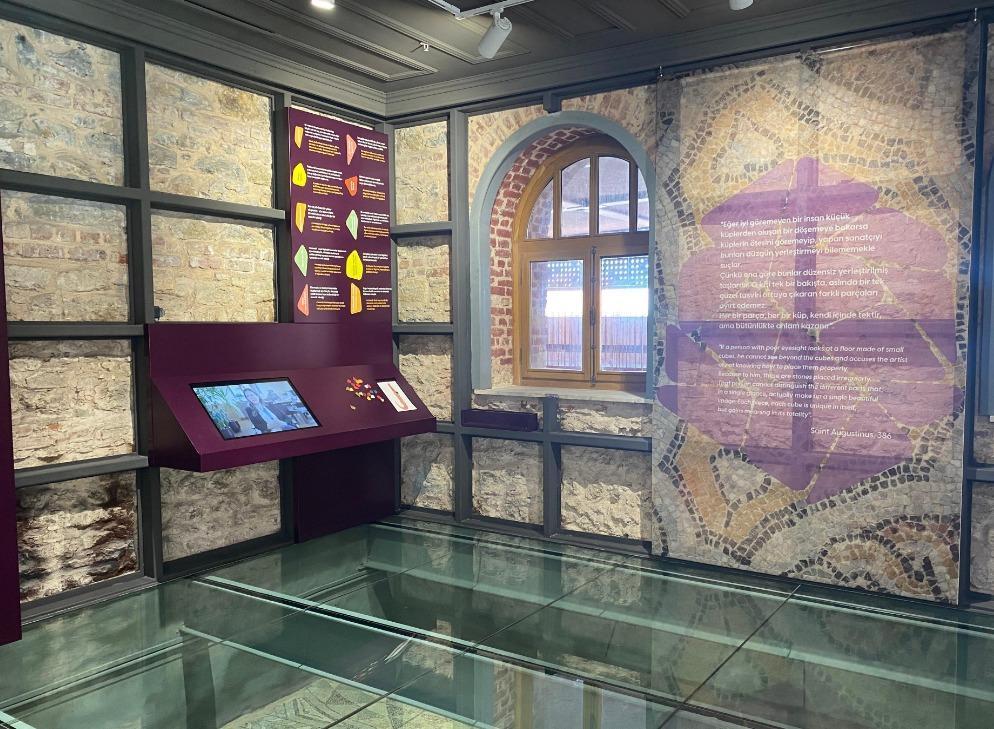Thousands of years of finds on display at Kazlıçeşme
ISTANBUL

The Kazlıçeşme Arts Center, which has an impressive mosaic floor, sarcophagus and a tomb, welcomes its visitors in a historical Ottoman-era building, which served as a military hospital during the Ottoman period, in Istanbul’s Zeytinburnu.
The first part of the mosaics was discovered during the restoration work carried out in 2015 in the historical building, which was built as a military hospital in 1828, and later began to serve as the Zeytinburnu Municipality Building in 1984.
During the excavation works that continued until 2018, the remaining parts of the mosaics were unearthed. A marble sarcophagus and a cist-type tomb, adjacent to the building, were also found under the mosaics.
Findings obtained from the sarcophagus and the studies on the bones reveled that the mosaics dated back to the Late Roman - Early Byzantine period. According to the carbon 14 results, the bones date back to between 221 and 38 A.D., while DNA tests are currently ongoing at the Middle East Technical University (METU) in Ankara.
According to examinations on the sarcophagus, which is thought to belong to the Byzantine emperor, one of the two skeletons in the sarcophagus, is 1,750 years old and the other 1,775 years old.
Work was also completed in another cist-type tomb. According to the carbon test, it was reported that the people in the sarcophagus lived between the third and fourth centuries, and that the woman was 30-40 years old and the man 40-50 years old. It was claimed that the man in this sarcophagus was the Byzantine Emperor because of the purple handkerchief as the color purple was the symbol of nobility in the Empire.
Also, a smaller mosaic area unearthed at the western end was preserved in situ and included in the museum.
Kazlıçeşme Sanat complex is made up of a library, art gallery, restaurant and cafe areas.
Zeytinburnu Mayor Ömer Arısoy, speaking about the discoveries made during the restoration at Kazlıçeşme Arts Center building said, “The structure was built as a military hospital in the 1890s, and after this function, it started to serve as the Zeytinburnu Municipality in 1984, after serving as a military branch, a dormitory for officers' children, and a sales shop. It served as the Zeytinburnu Municipality for 30 years. When the municipality moved to another building, this building was turned into a culture and arts center after restoration process.”
“The mosaic was discovered in 2016 during the restoration and opened to public display. But considering that there might be more mosaics in the area, excavations were initiated with the Istanbul Archaeology Museums. Then we found the other part of this mosaic and a sarcophagus and the remains of two individuals inside the sarcophagus. They date back 1,755 years. This is the largest mosaic found outside the Istanbul city walls. Some parts of the mosaic got damaged but experts completed these damaged elements. On paper, at least, we can see the entire mosaic. As far as we know, the sarcophagus is the oldest one in this region. In addition, a burial chamber was discovered.”
Arısoy said that the ground floor of the building now serves as an art gallery, which is Kazlıçeşme Sanat, adding, “Inside this building, we also have a room with mosaics on the floor and a Mosaic Museum, which is located outside this building. We turned the last floor of the building into an art library. We opened the Mosaic Restaurant and Cafe by transforming a building nearby. We also have a venue for events.”
















